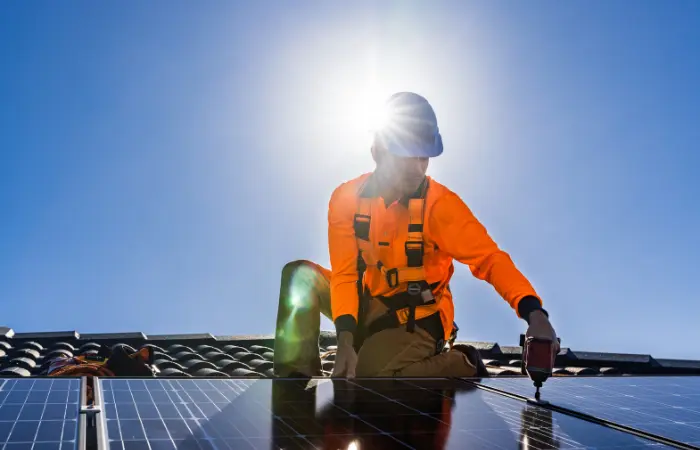Maximizing Solar Potential: Determining the Ideal Roof Space for a 6.6 kW Solar System in Australia
In recent years, solar energy has emerged as a sustainable and cost-effective solution for powering homes and businesses across Australia. With abundant sunlight and supportive government incentives, many Australians are opting to install solar panels on their rooftops. However, one common question that arises is: How much roof space is needed for a 6.6 kW solar system? In this article, we delve into the factors that influence the space requirements and provide insights into optimizing your solar potential.
Understanding Solar System Capacity:
Before delving into roof space requirements, it’s essential to grasp the concept of solar system capacity. The capacity of a solar system is measured in kilowatts (kW) and refers to the maximum amount of power it can generate under ideal conditions. A 6.6 kW solar system, for instance, can produce up to 6.6 kilowatts of electricity per hour under optimal sunlight conditions.
Factors Influencing Roof Space Requirements:
Several factors influence the amount of roof space needed for a 6.6 kW solar system:
1. Panel Efficiency: Solar panels come in various sizes and efficiencies. Higher efficiency panels can generate more power per square meter, reducing the overall space requirements.
2. Orientation and Tilt: The orientation and tilt angle of your roof can impact the efficiency of solar panels. Ideally, roofs facing north with a tilt angle matching the latitude of your location receive maximum sunlight exposure throughout the day.
3. Shading: Shading from nearby trees, buildings, or obstructions can significantly reduce solar panel efficiency. It’s essential to assess the shading on your roof to determine the available space for solar panels.
4. Local Climate: The amount of sunlight your location receives throughout the year influences the performance of solar panels. Regions with more sunlight may require fewer panels to achieve the same energy output.

Calculating Roof Space Requirements:
To determine the roof space needed for a 6.6 kW solar system, you can use the following formula:
Roof Space (m2) = System Capacity (kW)/ Panel Efficiency (kW/m2)
Keep in mind that panel efficiency varies based on the type and brand of solar panels you choose. On average, a standard solar panel with an efficiency of around 18% may require approximately 18-20 square meters of roof space for a 6.6 kW system.
Maximizing Solar Potential:
To maximize the potential of your solar system and minimize roof space requirements, consider the following tips:
1. Choose High-Efficiency Panels: Opt for solar panels with higher efficiency ratings to generate more power from limited roof space.
2. Optimize Roof Orientation and Tilt: If possible, orient your panels to face north and adjust the tilt angle for maximum sunlight exposure.
3. Minimize Shading: Trim trees or remove obstructions that cast shadows on your roof to maximize sunlight exposure throughout the day.
4. Consider Roof Size and Layout: Assess the available roof space and consider alternative layouts or configurations to accommodate the solar panels efficiently.

Conclusion:
Investing in a 6.6 kW solar system can significantly reduce your electricity bills and lower your carbon footprint. By understanding the factors influencing roof space requirements and implementing strategies to maximize solar potential, you can harness the power of the sun effectively. Whether you’re a homeowner or a business owner, going solar offers a sustainable solution for meeting your energy needs while contributing to a greener future.
Here are some of the most frequently asked questions regarding roof space requirements for a 6.6 kW solar system in Australia:
The exact roof space required can vary based on factors like panel efficiency, orientation, shading, and local climate. On average, a 6.6 kW solar system may require approximately 18-20 square meters of roof space with standard efficiency panels.
Solar panels can be installed on various roofing materials, including metal, tile, and asphalt shingles. However, it’s essential to ensure that your roof is structurally sound and free from damage to support the weight of the solar panels.
While north-facing roofs are ideal for maximizing sunlight exposure, solar panels can still be installed on east or west-facing roofs, albeit with slightly reduced efficiency. A professional solar installer can assess your roof’s orientation and recommend the best placement for optimal performance.
Yes, shading from trees, buildings, or other obstructions can significantly impact solar panel efficiency. It’s crucial to minimize shading on your roof to maximize sunlight exposure throughout the day and optimize the performance of your solar system.
While smaller roofs may have limited space, it’s still possible to install a 6.6 kW solar system with proper planning and optimization. Choosing high-efficiency panels and minimizing shading can help maximize the solar potential of a smaller roof.
The number of solar panels required depends on factors like panel wattage, efficiency, and available roof space. A professional solar installer can conduct a site assessment and provide a customized quote based on your specific energy needs and roof characteristics.
Yes, various government incentives, such as the Small-scale Renewable Energy Scheme (SRES) and feed-in tariffs, are available to encourage the adoption of solar energy. These incentives can help offset the upfront cost of installing a solar system and make it more affordable for homeowners and businesses.
The payback period for a solar system depends on factors like installation cost, energy usage, local electricity rates, and solar system performance. On average, homeowners can expect to recoup the cost of their solar investment within 5-10 years through energy savings and government incentives.


